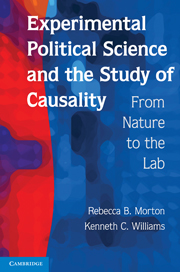Book contents
- Frontmatter
- Contents
- Acknowledgments
- I INTRODUCTION
- II EXPERIMENTAL REASONING ABOUT CAUSALITY
- III WHAT MAKES A GOOD EXPERIMENT?
- 7 Validity and Experimental Manipulations
- 8 Location, Artificiality, and Related Design Issues
- 9 Choosing Subjects
- 10 Subjects' Motivations
- IV ETHICS
- V CONCLUSION
- References
- Author Index
- Subject Index
7 - Validity and Experimental Manipulations
Published online by Cambridge University Press: 05 June 2012
- Frontmatter
- Contents
- Acknowledgments
- I INTRODUCTION
- II EXPERIMENTAL REASONING ABOUT CAUSALITY
- III WHAT MAKES A GOOD EXPERIMENT?
- 7 Validity and Experimental Manipulations
- 8 Location, Artificiality, and Related Design Issues
- 9 Choosing Subjects
- 10 Subjects' Motivations
- IV ETHICS
- V CONCLUSION
- References
- Author Index
- Subject Index
Summary
In the previous chapters we have examined both experimental and nonexperimental research, taking a largely common perspective. Although we have mentioned some of the differences between experimental work and nonexperimental analysis and some of the different types of experimental research, we have generally focused on commonalities rather than distinctions. Yet, the differences in approaches can be important and many are controversial. In this part of the book we turn to these differences. Usually the controversies have to do with arguments about the validity, robustness, or generality of particular experimental designs. Thus, before we turn to the specific differences, we begin with a review of the concept of validity in research. Then we turn to particular and sometimes controversial issues in experimentation such as the location of an experiment (whether lab or field), the subjects recruited (whether subjects are students), and how the subjects are motivated (whether financial incentives are used).
Validity of Experimental Research
Suppose that we have conducted some empirical research with either experimental or nonexperimental data. We ideally want a research design that will provide us with valid results that are true for the population we are analyzing and robust results that generalize beyond our target population (see Definition 2.2). So, for example, before we begin to study the effect of information on voting – the effect of changes in Ti on Yi – we would like to come up with an experimental design that will give us results that meet these criteria.
- Type
- Chapter
- Information
- Experimental Political Science and the Study of CausalityFrom Nature to the Lab, pp. 253 - 276Publisher: Cambridge University PressPrint publication year: 2010



